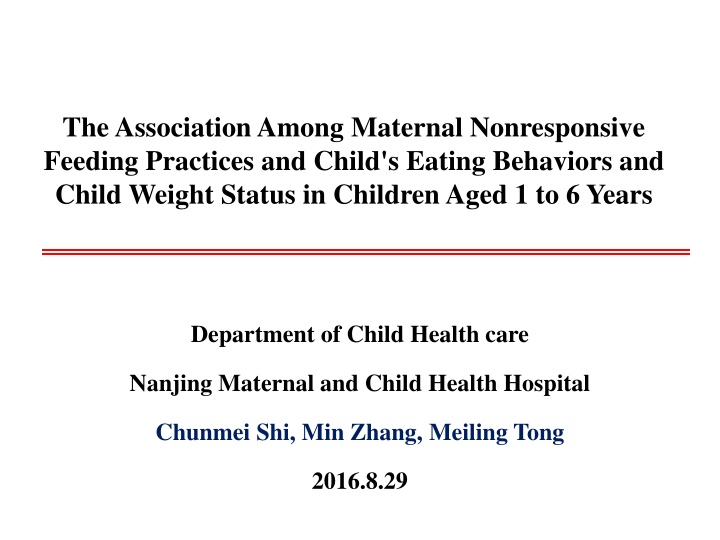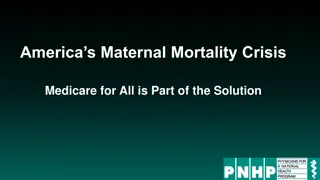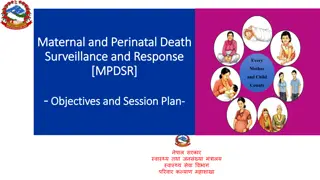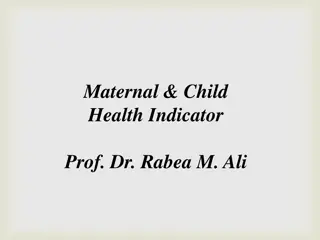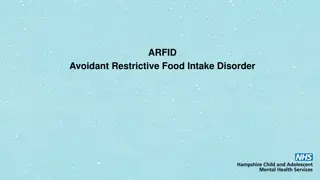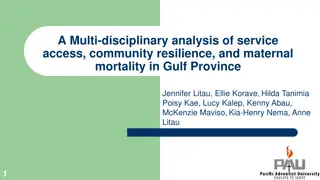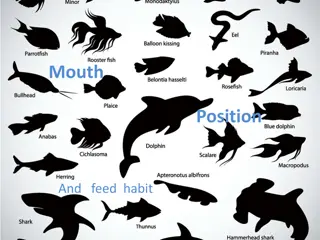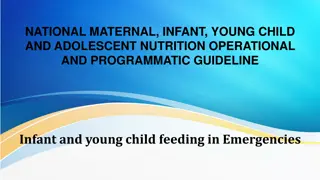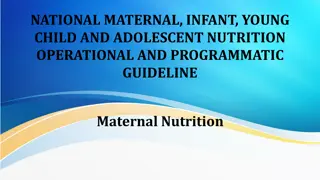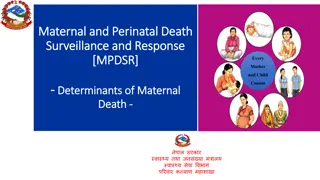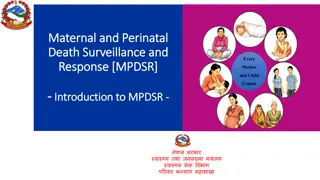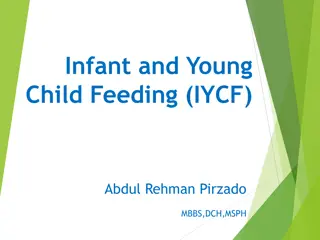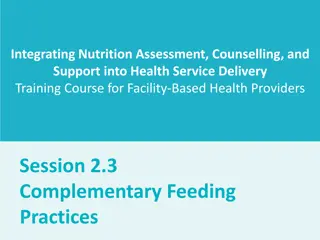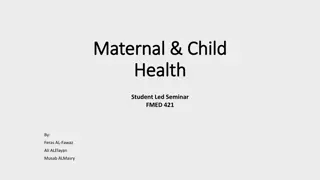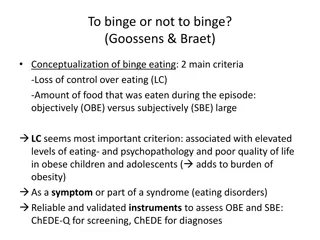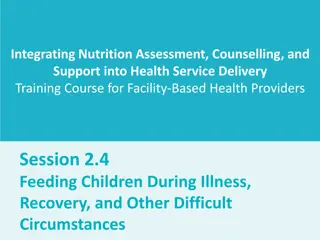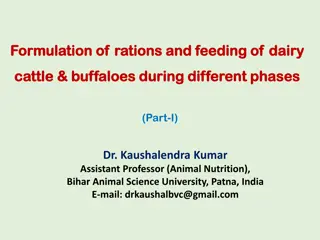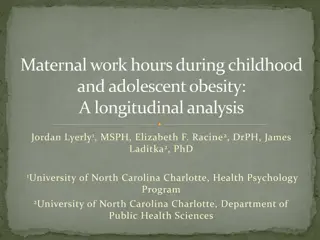Maternal Nonresponsive Feeding Practices and Child Eating Behaviors
This study explores the association between maternal nonresponsive feeding practices and child's eating behaviors and weight status in children aged 1 to 6 years. It discusses concepts like responsive parenting, parental responsivity, and nonresponsive parenting in relation to child feeding practices, highlighting the impact on child weight status and eating habits. The Responsive Feeding Questionnaire (RFQ) is also introduced as a tool to assess nonresponsive feeding practices based on closed-ended items related to restriction, pressuring, and parental involvement during mealtimes.
Download Presentation

Please find below an Image/Link to download the presentation.
The content on the website is provided AS IS for your information and personal use only. It may not be sold, licensed, or shared on other websites without obtaining consent from the author.If you encounter any issues during the download, it is possible that the publisher has removed the file from their server.
You are allowed to download the files provided on this website for personal or commercial use, subject to the condition that they are used lawfully. All files are the property of their respective owners.
The content on the website is provided AS IS for your information and personal use only. It may not be sold, licensed, or shared on other websites without obtaining consent from the author.
E N D
Presentation Transcript
The Association Among Maternal Nonresponsive Feeding Practices and Child's Eating Behaviors and Child Weight Status in Children Aged 1 to 6 Years Department of Child Health care Nanjing Maternal and Child Health Hospital Chunmei Shi, Min Zhang, Meiling Tong 2016.8.29
Responsive parenting Interactive behaviors between caregivers and children Sensitive to child s cues Prompt Appropriate World Health Organization. Infant and young child feeding: Model Chapter for textbooks for medical students and allied health profession[M]. Geneva: World Health Organization, 2009: 16, 20.
Parental Responsivity - applied to feeding Sensitive to child s cues Respond to child s cues: Prompt Appropriate Development/age Culture Situation Responsive Feeding Black & Aboud, J Nutr, 2010
Nonresponsive parenting Giving children whatever they want. Letting children be in charge of what they want, whenever they want it.
WHAT IS NON-RESPONSIVE FEEDING? Excessive parental control Forceful Eat! Eat! Underweight children remain underweight Restrictive No dessert for you! Overweight children remain overweight Fisher & Birch, AJCN, 1999
WHAT IS NON-RESPONSIVE FEEDING? Lack of parental control Indulgence Eat whatever you want Risk of overweight / obesity Uninvolved Eats meals alone Risk of underweight 0166-0511-1221-5433_TN
Responsive Feeding Questionnaire (RFQ) 3 closed-ended items ("yes" means there exists nonresponsive feeding practices): 1) Restriction: You only give child to eat what you like or what you think is good food; 2) Pressuring: If child refuses to eat, you will force or trick him/her to continue to eat a certain amount of food; 3) Uninvolved or neglectful: No or little active physical help during mealtimes.
Child Eating Behavior Questionnaire (CEBQ) 10 closed-ended items: 1) child prefers high-calorie food? ; 2) child rarely eats vegetables / fruits food?; 3) child prefers snacks, thus affecting the regular meal; 4) child refuse to accept new foods; 5) child often refuses to open mouth or push away food?;
Child Eating Behavior Questionnaire (CEBQ) 10 closed-ended items continue: 6) child always has food in her mouth; 7) child eats very slow; 8) when eating, child is easily distracted; 9) the place where child eats is not fixed, he/she would stop participating and start walking around; 10) feeding child is often a struggle.
Basic information of the investigated subjects Age group (months of age) Characteristics Total 12 13-18 19-24 25-36 37-48 49-60 61-72 Boy 158(52.5) 230(55.4) 192(54.2) 441(54.2) 186(53.0) 69(58.0) 40(58.0) 1316(54.3) Child gender (%) Girl 143(47.5) 185(44.6) 162(45.8) 373(45.8) 165(47.0) 50(42.0) 29(42.0) 1107(45.7) High 64(21.3) 30(7.2) 49(13.8) 141(17.3) 74(21.1) 35(29.4) 11(15.9) 404(16.7) School Undergra duate Maternal 152(50.5) 295(71.1) 241(68.1) 516(63.4) 219(62.4) 59(49.6) 43(62.9) 1525(62.9) educational level Graduate 85(28.2) 90(21.7) 64(18.1) 157(19.3) 58(16.5) 25(21.0) 15(20.4) 494(20.4) < P15 16(5.3) 22(5.3) 17(4.8) 109(13.4) 41(11.7) 19(16.0) 15(21.7) 239(9.9) P15-P85 191(63.5) 282(68.0) 246(69.5) 549(67.4) 246(70.1) 81(68.1) 45(65.2) 1640(67.7) Child s BMI percentile[19] P85-P95 67(22.3) 80(19.7) 70(19.8) 97(11.9) 39(11.1) 11(9.2) 4(5.8) 374(15.2) > P95 27(9.0) 31(7.5) 21(5.9) 59(7.2) 25(7.1) 8(6.7) 5(7.2) 176(7.3) Total 301 415 354 814 351 119 69 2423
Eating behavior problems detected in different age groups of children 60 Keeping food in mouth 80 Preferring high- calorie foods Rarely eating fruits or vegetables Preferring junk food Refusing new foods 50 70 Meal time >30min 60 40 50 40 30 Meal inattention 30 20 20 Meals at non- permanent locations Feeding struggle 10 10 Refusing to eat 0 0
The detection rates of maternal nonresponsive feeding in children aged 1 to 6 years 70 60 50 40 Restriction Pressure to eat Uninvolved 30 20 10 0
Correlations between maternal nonresponsive feeding practices and child s eating behaviors OR for weight status of children (95% CI) Preferring high-calorie foods Rarely eating vegetable /fruits Preferri Refusin Refusin g to eat Keeping food in mouth Meal Meal Meals at Feeding struggle ng junk food g new foods time >30min inattention non-permanent locations Restriction 1.52 2.09 1.86 1.77 1.76 1.37 1.25 1.41 1.72 1.66 (1.24, 1.86) (1.69, 2.59) (1.49, 2.32) (1.43, 2.18) (1.42, 2.16) (1.11, 1.70) (1.03, 1.52) (1.13, 1.74) (1.41, 2.08) (1.36, 2.04) Pressure 1.70 1.73 1.80 1.59 2.88 2.98 3.18 3.58 2.73 4.71 (1.39, 2.08) (1.38, 2.16) (1.43, 2.27) (1.28, 1.97) (2.31, 3.60) (2.38, 3.73) (2.64, 3.82) (2.98, 4.30) (2.30, 3.256) (3.84, 5.77) Uninvolved 1.42 2.12 2.25 1.62 2.65 2.15 2.31 2.09 2.10 3.35 (1.16, 1.74) (1.71, 2.63) (1.81,2.80) (1.31, 2.00) (2.16, 3,24) (1.75, 2.65) (1.91, 2.79) (1.68,2.61 ) (1.73, 2.55) (2.75,4.08)
Association of childs eating behaviors and maternal nonresponsive feeding practices with Child s BMI BMI ( 2) months of age 12 13-18 19-24 25-36 37-48 49-60 61-72 Gender 0.15 12.96** 1.30 0.33 5.78 4.01 7.71 Maternal education level 18.00** 19.49** 9.34 12.27 15.15* 7.30 22.02*** Preferring high-calorie foods 8.17* 8.76* 4.16 6.46 1.19 6.66 5.88 Rarely eating fruits or vegetables Preferring junk food 7.26 1.75 3.96 0.13 1.03 3.18 9.51* 12.30** 6.76 5.32 14.22** 2.87 4.25 0.96 Refusing new foods 4.19 21.09*** 11.86** 19.03*** 8.57* 19.49*** 3.65 Refusing to eat 2.64 1.73 0.52 3.76 6.53 1.69 3.00 Keeping food in mouth 4.39 3.72 2.59 2.10 7.97* 1.56 1.75 Meal time >30min 3.45 8.03* 0.91 6.54 4.80 1.24 3.54 Meal inattention Meals at non-permanent locations Feeding struggle 8.45* 5.30 0.23 7.41 8.50* 6.05 2.50 5.57 3.35 3.11 7.69 8.54* 3.69 1.93 6.94 3.85 0.52 2.19 9.96* 2.96 0.38 Restriction 6.01 12.30** 4.80 2.07 4.78 1.15 5.84 Pressure to eat 5.85 4.20 4.78 5.30 8.15* 6.77 2.38 Uninvolved 2.83 0.09 0.79 3.45 7.64 5.16 4.33
Association of maternal nonresponsive feeding practices and child s eating behavior with children s BMI Child Weight status, OR (95% CI) Normal weight Variables Underweight Overweight Obese 12 months of age Preferring junk food Meal inattention Pressure 1.04(0.10, 11.03) 0.35(0.10, 1.22) 0.23(0.06, 0.91)* Reference Reference Reference 4.63(1.46, 14.68)** 2.10(1.04, 4.22)* 1.29(0.68, 2.46) 2.79(0.62, 12.57) 1.76(0.65, 4.78) 0.77(0.30, 1.99) 13-18 months of age Refusing new foods Meal inattention 5.23(1.84,`4.92)** 0.36(0.11, 1.17) Reference Reference 0.96(0.48, 1.91) 1.18(0.62, 2.25) --- 3.57(1.03, 12.38)* 19-24 months of age Refusing new foods 3.28(1.10, 9.82)* Reference 0.86(0.44, 1.70) ---- 25-36 months of age Preferring junk food 0.33(0.17, 0.67)** Reference 1.06(0.60, 1.88) 1.21(0.60, 2.43) 37-48 months of age Keeping food in mouth 0.24(0.07, 0.81)* Reference 1.06(0.43, 2.62) 1.29(0.39, 4.27) Meal inattention 3.02(1.24, 7.36)* Reference 1.17(0.42, 3.21) 1.31(0.44, 3.97) 49-60 months of age Refusing new food Meal inattention Feeding struggling 11.71(2.63, 52.18)** 0.70(0.11, 4.56) 1.33(0.22, 8.01) Reference Reference Reference 0.23(0.02, 3.08) 18.03(1.15, 281.72)* 0.04(0.00, 0.48)* ---- 0.35(0.04, 3.32) 0.15(0.01, 3.07) 61-72 months of age Restriction 6.53(1.24, 34.48)* Reference --- ---
Limitations Observational study Hospital base-Population
Conclusions Evidence: Nonresponsive feeding practice and child s eating behavior Key developmental age: 19-24 and 49-60 months Red Flag: Refusing new food, eating at non-permanent locations, Preference to junk food and inattention; Restriction and pressure
Thanks Evolution not revolution, No one will fail new standards.
